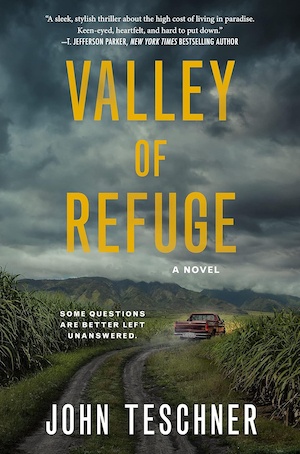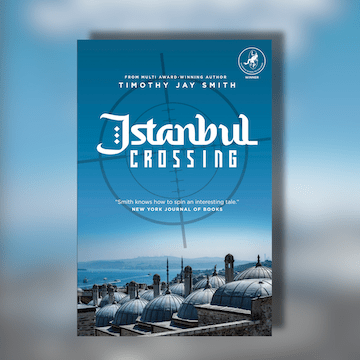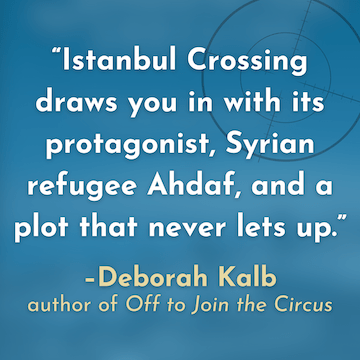
Valley of Refuge, the new thriller by John Teschner, starts off more like a mystery. At least it was a mystery to me, with three intriguing stories evolving at once. First, social media magnate Frank Dalton is doing something big on the Big Island of Hawai`i, then there’s a woman flying to the state who has completely lost her memory and doesn’t really recognise the person her passport says she is, and third is a young Hawaiian woman, Nalani, whose ancestral lands it seems the magnate wants.
As the stories move forward – and especially as the memory of the woman called Janice Diaz gradually returns, these strands weave into a tightly constructed, complex plot. Teschner packs plenty of it into the novel’s seven-day timeline and the action takes place almost exclusively in Hawai`i, with elegant descriptions of the topography and plant life, the fishing and surfing, the sunsets and weather – including a cataclysmic rainstorm at the climax that will make you feel drenched.
Frank Dalton heads a company called Sokoni that dominates the social media world. Make that ‘the world’. But for someone who amassed his fortune enabling people to make connections with each other, his project in Hawai`i is the antithesis of that. He’s building a no-expense-spared refuge to keep people out. It will have massive security measures to protect him, his wife and two sons against every conceivable risk. He should know that’s an impossibility, as the fractures and shortcomings of his team and his plans reveal consistently. But his plan is on a par with the ultra-wealthy who’re seeking to ride out the apocalypse in remote New Zealand and elsewhere.
Janice Diaz is whisked from the plane to a hospital where an overdose of amphetamines is treated, then turned out on the street. No luggage. No reservations that she knows of. No friends or family. She has a phone, but doesn’t remember its security code. Luckily, she meets a savvy homeless woman who introduces her to the hidden culture of the island’s destitute. By banding together, they have food and shelter and stay safe. That last is especially important to Janice, as it appears someone is trying to kill her.
Returning memory brings an unwanted understanding of who she was, what she’d been up to, and why she’d travelled to Hawai`i. She is part of a rogue group trying to bring down Sokoni for its hegemonic tendencies. Her group planned some sort of assault, but its members are not expert in that kind of operation and had been recruited from unsavory white supremacist sources. The possibility for trouble on an island where the nearly everybody is multiracial is scary.
The scenes with Nalani and her mother, a former drug addict, and her Uncle Solomon, who knows the ways of nature – land and sea alike – contrast starkly with Dalton’s world. He is determined to acquire title to their tiny parcel of land because the law allows them to drive through his property any time they want to reach it. For him, their holding creates an intolerable security gap. For the Hawaiians, giving up the land not only would violate the established order, the ahupua`a, but land is a family’s identity. As long as they stay strong on the land, they believe they’ll have everything they need. The Hawaiians are happy with their meagre parcel and one-room shack, while Dalton’s multimillion dollar estate fills him with anxiety.
It takes a while for the characters’ roles in the story to shape up, and Teschner uses short chapters to bounce you from one intriguing plot point to another. The pace gradually picks up steam, acquiring such strong narrative power that the last day’s events rush forward like the storm itself.
All these characters are well realised, and I especially liked Janice Diaz, Nalani and the realtor struggling to finalise the transfer of Nalani’s family’s property. Naturally, it’s harder to warm to Dalton, with his narcissism and conviction he can control the universe, but that portrayal is effectively drawn too.
Teschner adds to the story’s realism by using a fair amount of the Hawaiian language – both by the Hawaiians and the whites who want to show how with it they are – but it isn’t hard to follow. Context usually takes care of it, and he provides a handy glossary in the back, just in case.
Also see Hokuloa Road by Elizabeth Hand.
Forge
Print
£23.98
CFL Rating: 5 Stars










